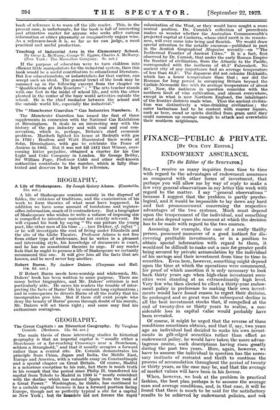GEOGRAPHY.
The Great Capitals : an Historical Geography. By Vaughan Cornish. (Methuen. 12s. 63. net.) The main thesis of these interesting studies in historical geography is that an imperial capital is " usually either a Storehouse or a far-reaching Crossways near a Storehouse, seldom a Stronghold," and that it usually occupies a forward rather than a central site. Dr. Cornish demonstrates his principle from China, Japan and India, the Middle East, Europe and America, with a valuable essay on Constantinople and a special chapter on Great Britain. Of course, Madrid is a notorious exception -to his rule, but there is much truth in his remark that the period since Philip II. transferred his capital from Toledo to Madrid in 1580 is " nearly coincident with the decline which has reduced Spain from the rank of a Great Power." Washington, he thinks, has continued to be a suitable capital because it has a forward position facing Europe, though not so perfectly typical a site for a capital as New York ; but -its -founders did not foresee the -rapid colonization of the West, or they would have sought a more central position. Dr. Cornish's collection of precedents makes us wonder whether the Australian Commonwealth's projected capital at Canberra, whose chief merit is -its remote- ness, will ever come into being and -flourish. We would draw special attention to the notable excursus—published in part in the Scottish Geographical Magazine recently—on " The Isothermal Frontier of Ancient Cities." It is a fact, first observed by Dr. Cornish, that under the early Roman Empire the frontier of civilization, from the Atlantic to the Pacific, corresponded with the isotherm of 48.5° Fahrenheit. No ancient city of any importance had an average temperature of less than 48;5°. The Japanese did not colonize Hokkaido, which has a lower temperature than that ; nor did the Romans for long persist in occupying Britain beyond the Carlisle-Newcastle line with its average temperature of about 48°. Now, the isotherm in question coincides -with the northern limit of vine cultivation, and almost everywhere, except in what is now Northern England, the inhabitants of the frontier districts made wine. Thus the ancient civiliza- tion was distinctively a wine-drinking civilization ; the outer barbarians had to be content with coarser liquors, such as beer, mead or spirits distilled from grain until they could summon up courage enough • to attack and overwhelm their southern neighbours.






































 Previous page
Previous page